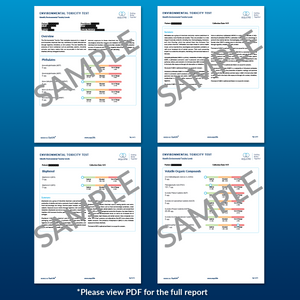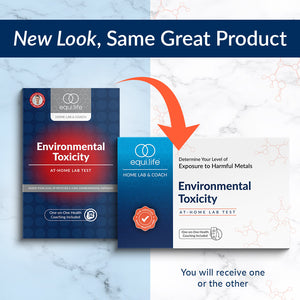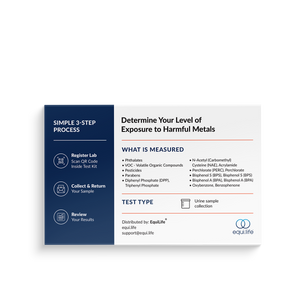



Do you feel like you are struggling to keep up with daily life, run down or simply not quite yourself? Skin rashes, brain fog, poor sleep and weakened immunity are just some of the common signs of years of environmental toxicity exposure from chemicals prevalent in today's world. With well over 77,000 man made chemicals infiltrating our environment, it's no longer a question of whether or not your body is harboring toxins, but rather how many. This Environmental Toxicity Test will show you your "Total Toxic Load" so you can assess where you're at now and help you make the best decisions about your health going forward.

Our exposure to environmental toxins is unavoidable and can have debilitating effects on our health. When toxin exposure builds up over time, the body can react with moderate to severe symptoms including skin rashes, poor sleep, headaches, brain fog, lowered mood, and higher levels of inflammation. Without discovering whether your symptoms may be caused by high exposure to toxins in your environment, your condition may worsen leading to poor health and more serious issues. This at-home lab test can be used as a comprehensive baseline to understand which toxic chemicals from the environment, pharmaceuticals and more that you have been exposed to.
When we are unaware of the effects that environmental toxins have on our body, we may spend tremendous energy and resources trying to solve mysterious health issues. This is one of the rare and easy to complete at-home labs that will show you once and for all how you're doing in terms of detoxing from some of the most harmful chemicals in the world. High levels of toxins can wreak havoc on our body's ability to function optimally and armed with your individual test results, an EquiLife Health Coach can clarify the important steps you can take to reduce overall toxicity levels, rebalance your body and improve your health. You'll also be able to see your progress as you begin to eliminate years of potential build-up and stored toxins.
Every day, we are exposed to hundreds of toxic chemicals through products like pharmaceuticals, pesticides, insecticides, herbicides, packaged foods, household products, and environmental pollutants in water, food and air.
This test measures 26 specific metabolites, the breakdown products that show how these toxins are processed in your body, providing a clear picture of your overall toxic burden.
Phthalates
Monoethylphthalate (MEP): Primary metabolite of diethyl phthalate, used in perfumes, lotions, and cosmetics.
Monobutylphthalate (MBP): Metabolite of dibutyl phthalate, common in adhesives, cosmetics, and nail polish.
Mono-2-ethylhexyl phthalate (MEHP): Primary metabolite of DEHP, found in medical devices, food packaging, and vinyl flooring.
Mono-(2-ethyl-5-oxohexyl) phthalate (MEOHP): Secondary metabolite of DEHP, formed after MEHP breakdown.
Monoisobutyl phthalate (MiBP): Metabolite of diisobutyl phthalate, present in plastics, coatings, and hair sprays.
Bisphenols
Bisphenol A (BPA): Common in plastics and epoxy resins, a known endocrine disruptor affecting hormones and metabolism.
Bisphenol S (BPS): BPA replacement in "BPA-free" products, with similar hormonal concerns.
Volatile Organic Compounds (VOCs)
2-,3-,4-Methylhippuric Acid (2-,3-,4-MHA): Metabolites of xylene, found in paints, gasoline, and industrial solvents.
Phenylglyoxylic Acid (PGO): Metabolite of styrene/ethylbenzene, used in plastics, insulation, and car parts.
N-Acetyl Phenyl Cysteine (NAP): Byproduct of benzene, a toxic compound in fuels and solvents.
N-Acetyl (2-Cyanoethyl) Cysteine (NACE): Metabolite of acrylonitrile, linked to acrylic fibers, carpets, plastics, and cigarette smoke.
N-Acetyl (Propyl) Cysteine (NAPR): Formed from 1-bromopropane, used in adhesives, dry cleaning, and electronics cleaning.
N-Acetyl (3,4-Dihydroxybutyl) Cysteine (NADB): Also from 1-bromopropane, with exposure from solvents in industrial cleaning.
2-Hydroxyethyl Mercapturic Acid (HEMA): Metabolite of ethylene oxide or vinyl chloride, used in plastics, antifreeze, and PVC.
Pesticides
Atrazine Mercapturate (AM): Metabolite of atrazine, a herbicide widely used in corn production, linked to hormone disruption.
2,4-Dichlorophenoxyacetic Acid (2,4-D): Common herbicide in agriculture and landscaping.
3-Phenoxybenzoic Acid (3-PBA): Breakdown product of pyrethroid insecticides, used in agriculture and pest control.
Diethylphosphate (DEP): From organophosphate pesticides, which interfere with nerve function.
Parabens
Ethylparaben (EtP): Preservative in cosmetics and drugs, absorbed through skin and ingestion.
Propylparaben (PrP): Found in foods, cosmetics, and drugs, linked to estrogenic activity.
Butylparaben (BuP): Used in sunscreens and processed foods, associated with endocrine disruption.
Methylparaben (MeP): Preservative in lotions and skincare, linked to oxidative stress and hormonal imbalance.
Other
Diphenyl Phosphate (DPP): Metabolite of triphenyl phosphate, a flame retardant in furniture, electronics, and nail polish.
N-Acetyl (Carbomethyl) Cysteine (NAE): Metabolite of acrylamide, formed in fried foods, coffee, and cigarette smoke.
Perchlorate (PERC): Used in fireworks, flares, and rocket fuel, disrupts thyroid iodine uptake.
Oxybenzone (OBZ): UV-filter chemical in sunscreens, plastics, and packaging, linked to endocrine disruption.
EquiLife labs are designed to provide detailed and thorough information so that you can understand your health at the deepest level, allowing you to finally get to the root cause of your biggest health concerns.
To ensure you feel confident about your lab findings, EquiLife provides a complimentary, one-on-one call with a certified Health Coach who will review your results with you in-depth and answer any questions you have.
Testing takes the guesswork out of your health and empowers you to make informed choices about your health. After reviewing your results, Health Coaches will provide recommendations to help you achieve your goals.
Get to the Root Cause
Once you receive your at-home lab test, please follow the instructions provided to register your test. Once sample(s) are sent to one of our CLIA certified labs, it will take approximately 3 weeks for your results to be returned, during which time you will receive information on how to schedule your one-one-one health coaching call.
All at-home lab tests expire 6-months from their purchase date. To ensure you will receive your results, please be sure to send all samples for completed lab tests prior to the 6-month expiration date. Unfortunately, there can be no returns or replacement lab tests sent after the 6-month time frame.
Please remember to register your labs prior to sending your sample to the laboratory.
We have compiled thorough FAQs for our at-home lab tests, which you can browse here:
https://faq.equi.life/en-US/articles/lab-kit-faq-14490
For additional questions, you can contact us at support@equi.life.



